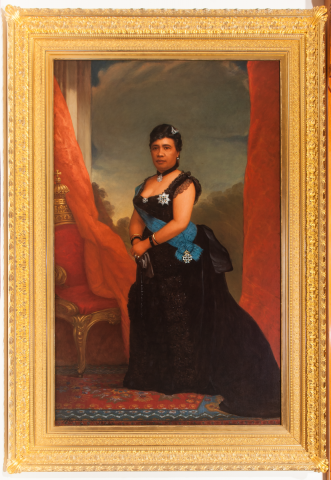
Queen Lili‘uokalani (1838–1917)
Here, Queen Lili‘uokalani stands next to the Hawaiian throne, with adornments that speak to
her royal status and femininity. Employing a grand manner style, the artist conveyed the queen’s power as a female Kānaka Maoli, or Native Hawaiian, head of state but did so without a scepter or other symbols of absolute power. Instead, the painting portrays her as head of the constitutional monarchy established by the 1852 Ke Kumukānāwai o Ko Hawai‘i Pae ‘Āina (Hawaiian Constitution), which granted universal suffrage to all men regardless of race.
The queen’s purchase of this portrait in 1892, and its subsequent installation in the ‘Iolani Palace, stressed the legitimacy of the Hawaiian monarchy in the face of foreign threat. Her actions follow a long tradition of using—and sometimes subverting— Western art forms to assert Hawaiian sovereignty. Nevertheless, the monarchy was overthrown in 1893, which eventually led to the annexation of Hawai‘i as a U.S. territory in 1898.
Audio Transcription: When I look at the portrait of Queen Lili’uokalani, and the 'ahu 'ula, I see regalia and symbols of power. The 'ahu 'ula, the feather cape, comes from 'ahu, which translates as a garment for the upper body, and 'ula, meaning red or sacred or regal, dealing with the high chiefs and gods. And it is traditional Hawaiian feather work. They come from birds which fly above us in the heavens, so you also have that connotation. But yellow was the hardest to collect, and so that imbues more mana or power to this 'ahu 'ula. An 'ahu 'ula is comprised of thousands of feathers. It can take generations for an 'ahu 'ula to be made. Looking at the portrait of Queen Lili’uokalani, she is wearing her black ribbon dress in the portrait, which was worn to Queen Victoria's Jubilee in 1887, with honors of the Hawaiian Kingdom, specifically the Royal Order of Kalākaua, with a breast badge and sash. She wears the symbols of Hawaiʻi translated into European honors. The Hawaiian Kingdom was quick to adapt, and saw that other world powers had honor systems and the kingdom developed its own to show that Hawaiʻi was on equal footing in this worldwide community of nations and monarchs.
– My name is Tory Laitila. I am the curator of textiles and historic arts of Hawaiʻi at the Honolulu Museum of Art.